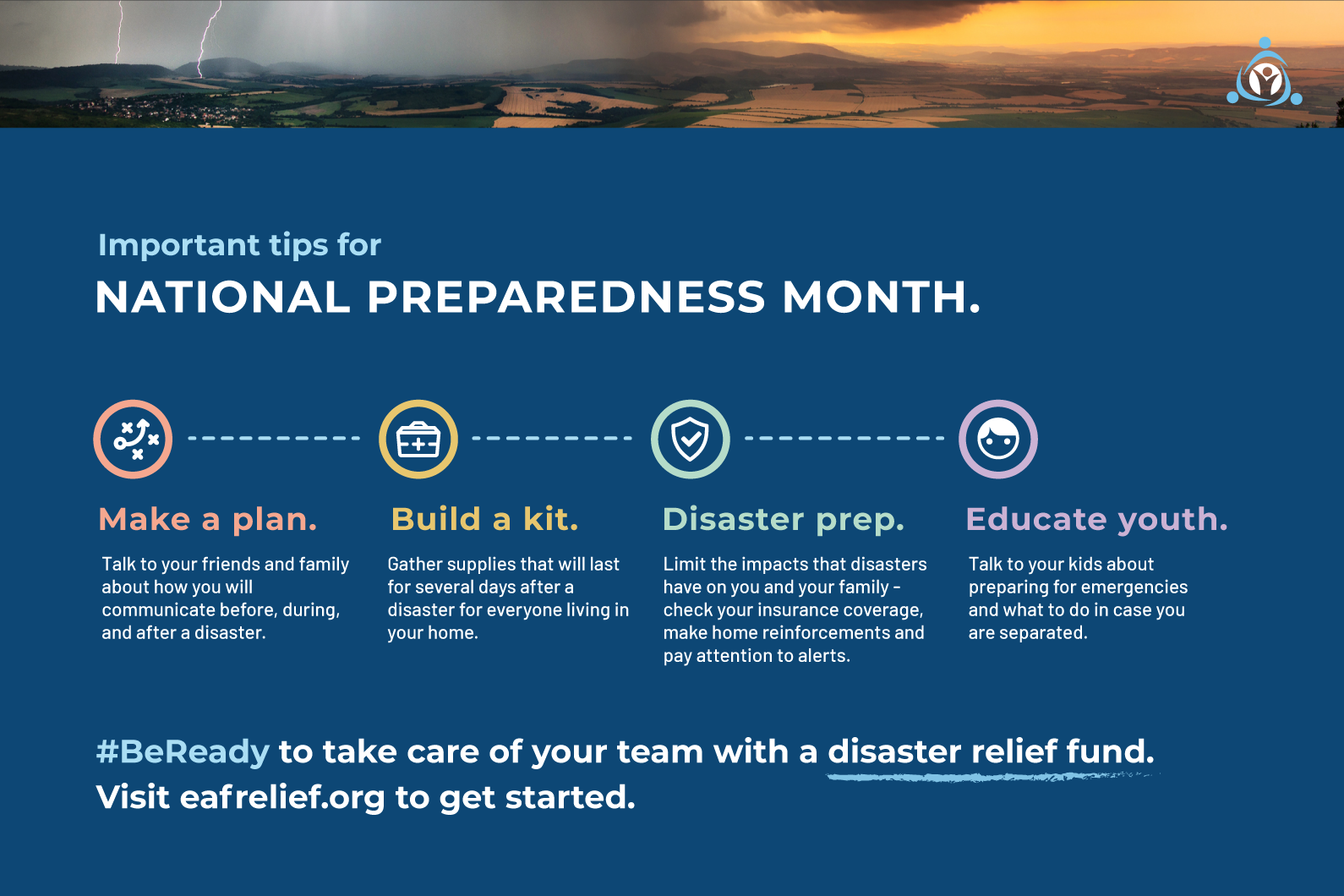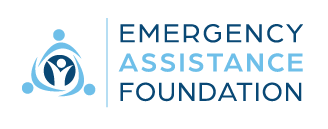
Severe Summer Weather & Heat Wave Relief
July 21, 2023
Domestic Violence Awareness: A Call to Action in 2023
September 25, 2023Aug 25, 2023
Disasters and emergencies can strike at any moment, emphasizing the need for preparedness at individual, community, and organizational levels. As we move forward, it's essential to be prepared to respond to these disasters and emergencies quickly and efficiently. In addition to providing some preparation tips in this article, we’ll also explain how integrating relief funds into disaster preparedness plans can help us be ready to respond in times of crisis.
National Preparedness Month: Stats
National Preparedness Month is observed every September, focused on taking proactive steps in preparing for potential disasters and emergencies. The increasing frequency and intensity of natural disasters — from hurricanes and wildfires to floods and earthquakes — underscore the importance of being prepared. It's about building and sustaining a culture of readiness, ensuring that when disasters strike, the impact on lives and property is minimized.
Let’s take a look at some of the disasters that have occurred recently and the impact they had.

In 2022, a total of 387 natural hazards and disasters were recorded worldwide – affecting 185 million and causing almost $223.8 billion in economic losses.
While we are only part way through the current year, a number of significant and record-setting natural disasters have already occurred. So far, we at Emergency Assistance Foundation have supported grant recipients through global large-scale disasters including Typhoon Mawar in Guam, wildfires in Canada and Maui, severe flooding throughout the U.S., and the devastating earthquakes in Turkey and Syria.
The increasing frequency and intensity of natural disasters — driven in part by climate change — and other hardships underscore the urgent need for robust preparedness, response, and recovery strategies. Let’s take a look at some of the most important tips for staying prepared.
Disaster Prep Tips for Individuals
Being prepared involves a series of steps that individuals, families, and organizations can follow:
- Make a Plan: Discuss with family and friends how you'll communicate during and after a disaster. Organizations should also have plans to support team members during emergencies. Update your plans based on the latest recommendations, especially in light of ongoing global events like the COVID-19 pandemic.
- Build a Kit: Assemble supplies to sustain everyone in your household for several days post-disaster. Consider the unique needs of each individual and pet.
- Low-Cost, No-Cost Preparedness: Understand the risks in your area and take measures to strengthen your home against common hazards. Regularly review your insurance coverage.
- Teach Youth About Preparedness: Engage with children about emergency preparedness, ensuring they know what to do if separated from family.

Disaster Prep Tips for Organizations
Organizations play a pivotal role in disaster preparedness, ensuring the safety of their employees and the continuity of operations:
- Know Your Risks: Conduct a risk assessment to identify potential emergencies and prioritize them based on impact and likelihood.
- Build a Response Team: Engage experts from various departments to create a comprehensive disaster response plan.
- Establish an Evacuation Plan: Designate primary and secondary evacuation routes. Ensure routes are well-lit, marked, and accessible.
- Establish a Relief Fund: In the aftermath of a disaster, a relief fund can support affected team members. Consider establishing a fund with Emergency Assistance Foundation (EAF) for quick and efficient financial assistance, ensuring support reaches those in need.
The integration of relief funds into an organization’s CSR and HR strategy will be essential in mitigating the human and economic toll of future disasters and hardships on employees.
“In the aftermath of Typhoon Mawar here in Guam, the grant provided financial assistance at a speed faster than our local and federal governments. Most of the island’s suppliers were offline and only accepting cash. I was able to access cash for food, water, cleaning supplies, gas, and other necessities quickly and efficiently. I believe others might benefit from this immediate relief during the initial devastating stages where everything seems uncertain. I would like to deeply thank those who have donated to the fund and made the grant award possible for me and others who are experiencing similar difficulties. I am grateful for the immediate support they have provided in helping us recover from the devastation of Typhoon Mawar."
How Establishing a Disaster Relief Fund With Emergency Assistance Foundation Will Help Provide Aid
In the aftermath of a natural disaster, severe weather event, or other hardship, your organization can help impacted team members rebuild and recover with a disaster relief fund administered by Emergency Assistance Foundation. A relief fund can boost morale and encourage your internal communities to contribute directly to the support of fellow team members. Establishing a fund can alleviate the stress that disasters put on those within your organization and allow impacted individuals to start on the road to recovery.
If your organization is interested in starting a relief fund, consider establishing a fund with Emergency Assistance Foundation today. As a financial first responder, we are resourceful and fearless in ensuring that financial assistance reaches individuals in need, no matter the unique circumstances involved.
Once you establish a fund, you can also launch an Immediate Response Program (IRP) in the event of a qualified disaster to provide small grants quickly and efficiently. This is a unique, low-cost program, which is supplemental to a fund’s standard grant program and awards small grants (< $1,000) quickly in times of large-scale disasters like heat waves.
Proactively establishing a relief fund with Emergency Assistance Foundation ensures that your organization is ready to assist any team members that are impacted by natural disasters and other hardships, and it can even be life-saving. According to data analyzed for our landmark 10-year relief fund industry report, natural disasters are the number one event included in the grant criteria for funds that are established with Emergency Assistance Foundation.
In fact, 73% of the over 350 relief funds we administer include natural disasters in their grant criteria. The funds’ sponsoring organizations recognize the growing importance of taking care of their team members in the aftermath of a natural disaster. As the threat of natural disasters continues to increase, now is the perfect time to start preparing for how your organization will respond once the next disaster occurs.
By establishing a fund with us today, your organization can assist members of your team affected by increasing natural disasters and hardships. Relief fund grants can help impacted individuals pull through difficult times and start on the path toward recovery. If you’d like to learn more about how your organization can help your team during difficult times, you can review additional information about how a fund works or contact us today. We look forward to helping you make a difference for those who need it most!




